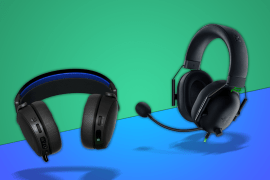Best soundbars in 2025 for every budget reviewed
Upgrade your substandard TV speakers with superior sound and Dolby Atmos: we've tested the best soundbar for every home setup
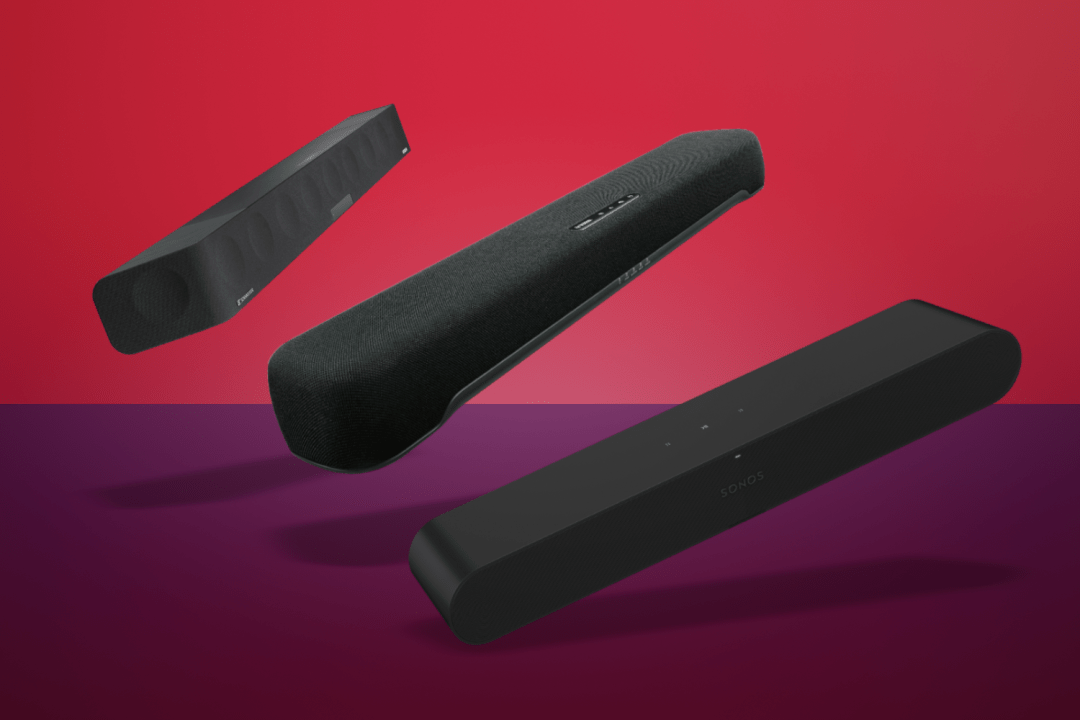
Slim TVs might look slick on your living room wall, but they don’t leave much space for speakers. And if there’s one way to ruin movie night, it’s with disappointing audio. Don’t fancy filling your room with surround sound speakers? These contenders for the title of best soundbar deliver beefy bass, room-filling volume and clarity that won’t leave you reading subtitles – all from a single bar that sits neatly beneath your TV.
So you don’t need a fleet of separates to sort your sub-par sound. Better yet, you don’t have to drop thousands to give your ears an upgrade – although there’s plenty of brilliant gear if your budget does stretch to several zeroes.
So whether you’re shopping for sound to fill your studio apartment or looking for a ‘bar to bring big-screen audio to your massive movie room, the list below features the very best soundbars for every pad and price tag. And if you’re looking for a new TV, then check out our best 4K TV guide. It’s also worth keeping in mind that many of these soundbars can pair with the best multi-room wi-fi speakers (as long as they’re compatible) to create a true 5.1 or 7.1 surround sound system.
Why you can trust Stuff: Our team of experts rigorously test each product and provide honest, unbiased reviews to help you make informed decisions. For more details, read how we test and rate products.
Quick list: what is the best soundbar?
We think the Sonos Arc (buy now) is the best soundbar you can buy. This Atmos-enabled soundbar presents a wide and spacious soundstage, with every element given plenty of breathing space. Detail levels are high and the bass is simultaneously deep. Add voice assistants, clever controls and multi-room into the mix and the Arc shapes up as a true all-in-one soundbar.
The Roku Streambar (buy now) squeezes the functionality of its widely admired streaming sticks into a small soundbar. Its four speakers offer a significant improvement on what most TVs can produce, with way more punch, presence and detail.
The Sonos Ray (buy now) bears the usual Sonos hallmarks and styling cues, the Ray’s premium build belies its relatively accessible price tag. Four amps, two tweeters and two mid-woofers work together with a bass reflex system to fill most spaces with superb sound.
The Sony HT-ST5000 (buy now) pumps out premium audio and uses a clever combination of speakers to give you an impressive sense of height. Google Home support and wide-ranging connectivity make it easy to set up, while hi-res audio is the icing on the cake.
Yes, the Bowers & Wilkins Formation Bar (buy now) is big and expensive, but the Formation Bar does plenty to justify its sizeable cost. Nine drivers – including three dedicated to the centre channel – are powered by a total of 240W, generating an extraordinarily wide yet precisely defined soundstage.
The Denon Home 550 (buy now) is a usefully compact soundbar with some Dolby Atmos support. It relies on algorithms to produce a 3D effect.
The Sonos Beam Gen 2 (buy now), with the addition of Dolby Atmos, makes Sonos’ already excellent compact soundbar even better.
The Dali Katch One (buy now) is perfect if you want an alternative to the big brands. It has fantastic audio and style to match.
The Sennheiser Ambeo Max Soundbar (buy now) is big, but the sound it makes is bigger still. There are 13 independent drivers inside: powered by 500W of Class D amplification.
The Samsung HW-S60B (buy now) is sturdy, and punchy. This compact soundbar is at its best when paired with a suitably fancy Samsung TV.
The best soundbars you can buy today:
Best soundbar overall
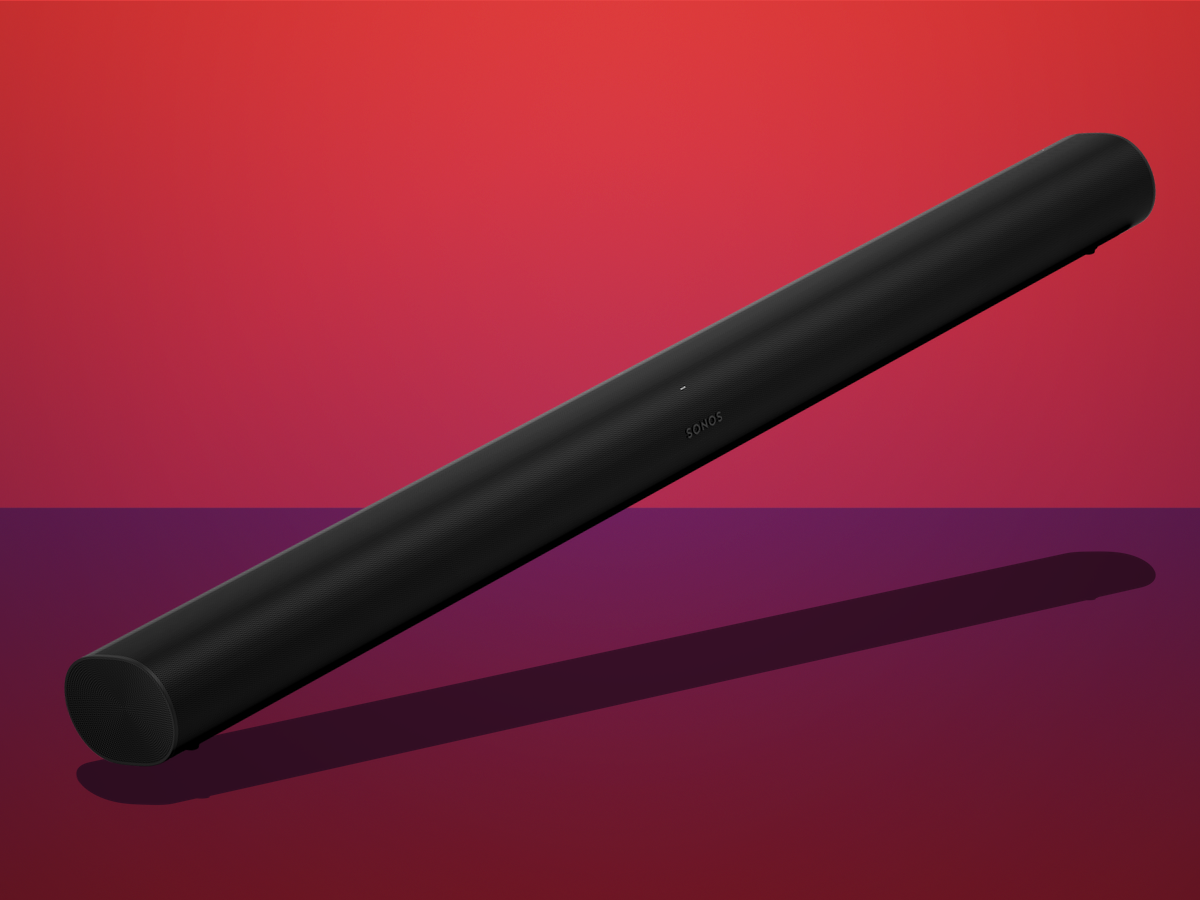
1. Sonos Arc
Stuff Verdict
At last, Sonos is able to give you the big-screen sound to go with those big-screen pictures.
Pros
- Wide, tall sound and impressive bass
- Adept with music as well as movies
Cons
- Slightly uneven frequency response
- No MQA support
| Sonos Arc specs | |
|---|---|
| Connectivity | HDMI, optical, ethernet |
| Format | Dolby Atmos, Dolby True HD, Dolby Digital+, Dolby Digital, DTS |
| Streaming | AirPlay 2, Sonos App |
| Dimensions | 8.7 x 114 x 12cm, 6.3 kg 3.4 x 44.9 x 4.7 in, 13.9 lb |
The Sonos Arc looks like a stretched Sonos speaker – which is mostly down to the matte-black or matte-white finishes, the perforated acoustic grille and the impeccable build quality. There’s nothing to surprise you, apart from the length – which, at 44.9in / 114cm, can make it look ungainly beneath TVs smaller than 55in.
Still, if you want to hear an Atmos-enabled ‘bar at its best, try the Arc. The soundstage is wide and spacious, with every element given plenty of breathing space. Detail levels are high, and it does an impressive job with the ‘height’ that’s such a crucial part of the Dolby Atmos effect.
Bass is simultaneously deep, substantial, nuanced and textured, while treble is bright, spilling into hardness only when you wind up the volume. Add voice assistants, clever controls and multi-room into the mix and the Arc shapes up as a true all-in-one soundbar for fans of the Sonos ecosystem.
- Read more: Sonos Arc review
Best Dolby Atmos soundbar
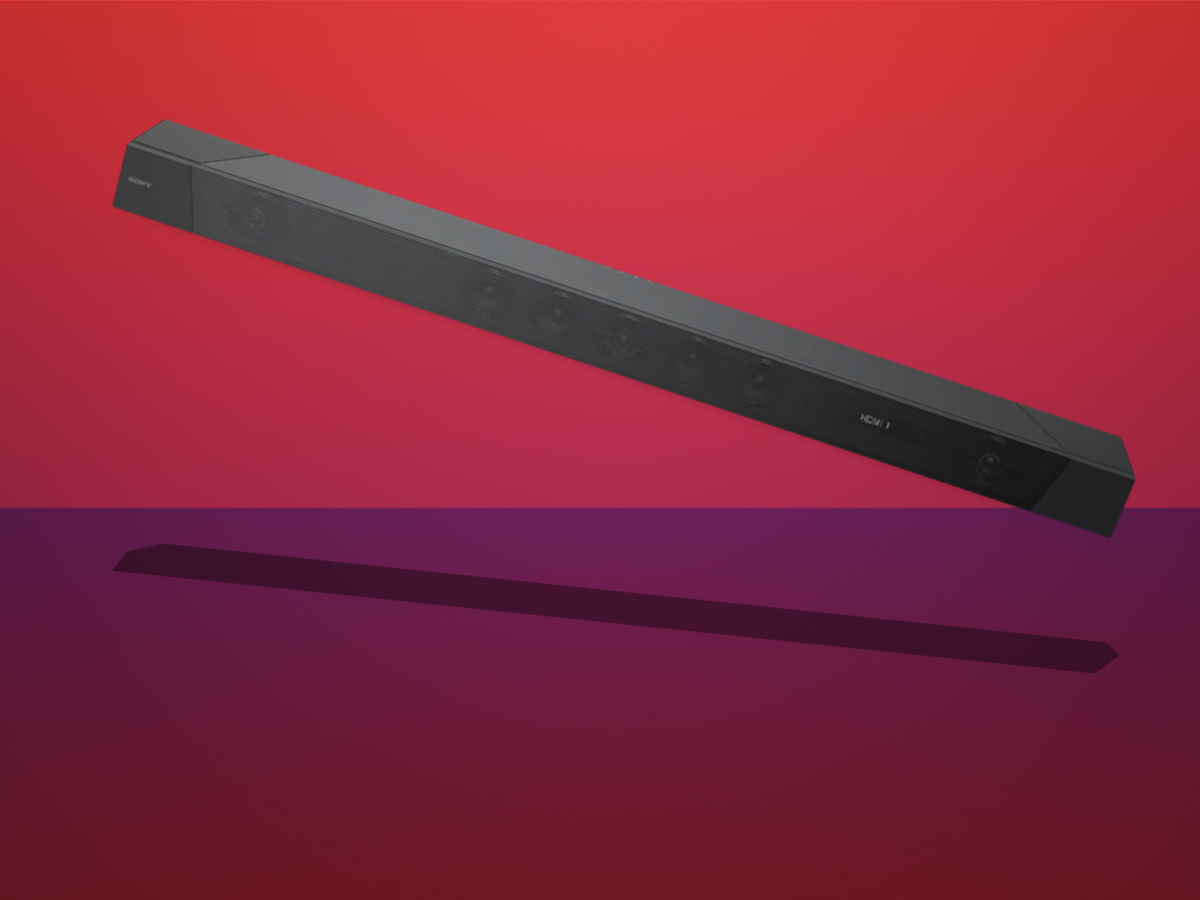
2. Sony HT-ST5000
Stuff Verdict
This Atmos soundbar from Sony is big, bold, and delivers plenty of performance.
Pros
- Excellent sound quality and Atmos effect
- So many connection options
Cons
- Large size
- Expensive
| Sony HT-ST5000 specs | |
|---|---|
| Connectivity | HDMI, optical, USB, Analog Audio In, Ethernet |
| Format | Dolby ATMOS, Dolby TrueHD, Dolby Digital+, Dolby Digital, Dolby Dual Mono |
| Streaming | Bluetooth, Chromecast built-in, Spotify Connect, Multiroom |
| Dimensions | 118 x 8 x 14.5 cm, 8.2kg 46.5 x 3.1 x 5.7 in, 18.1 lb |
At 46.5in / 118cm, Sony’s HT-ST5000 is almost as wide as the Sennheiser Ambeo found later in this guide, but with a separate subwoofer to deal with the whum-whum, it’s not such an absolute unit – although it retains the boxy, brushed metal look so synonymous with Sony’s audio equipment.
Three of the seven 65mm drivers across the front feature have tweeters mounted in the middle. These ‘coaxial’ combos ensure precise alignment of frequencies for an even sweeter sound, while two top-mounted drivers fire upwards to give you the sense of height that sets Dolby Atmos and DTS:X apart.
It performs magnificently, with S-Force Pro deftly using the front speakers to simulate surround sound without placing any additional units in your living room. Google Home support and wide-ranging connectivity make it easy to set up, while hi-res audio support is just the icing on a very wide cake.
Best cheap Sonos soundbar
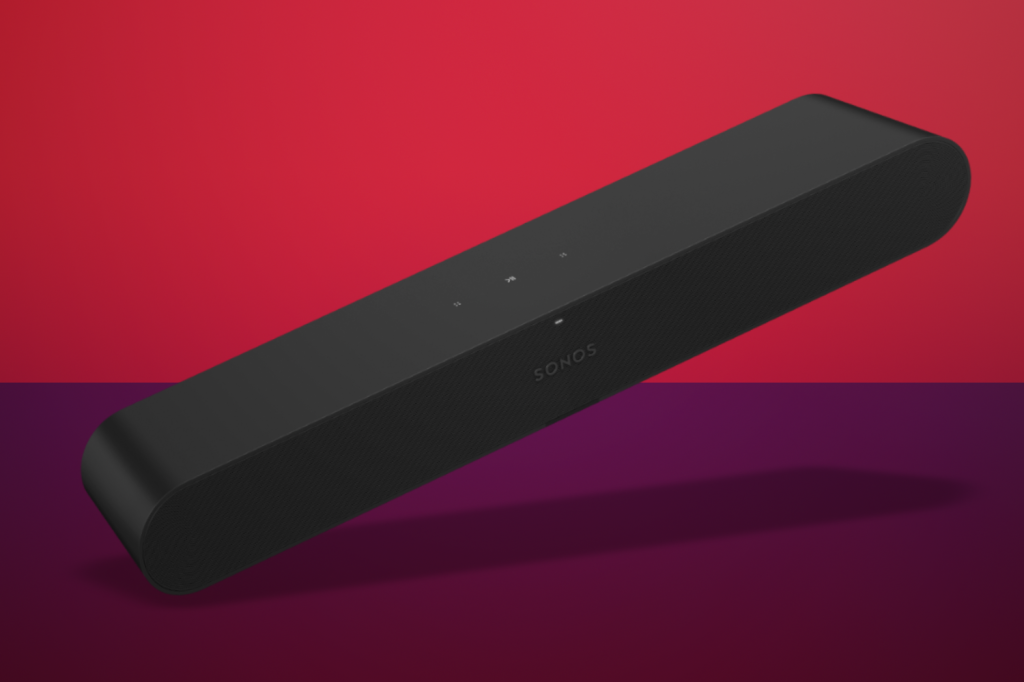
3. Sonos Ray
Stuff Verdict
A quality compact soundbar… but if you don’t own other Sonos kit you might want to look elsewhere.
Pros
- Lovely Sonos design
- Affordable (for a Sonos product)
Cons
- Patchy Bluetooth remote support
- No HMDI
| Sonos Ray specs | |
|---|---|
| Connectivity | Optical, Ethernet, IR receiver |
| Format | Stereo PCM, Dolby Digital 5.1, DTS Digital Surround |
| Streaming | Sonos app Wi-Fi, AirPlay 2 |
| Dimensions | 55.9 x 9.5 x 7.1 cm, 1.95kg 22 x 3.7 x 2.8 in, 4.3 lb |
Squeezing multi-room smarts into a compact bar, the Ray is a tempting accessory for owners of other Sonos speakers. Bearing the usual hallmarks and styling cues of Sonos kit, the Ray’s premium build belies its relatively accessible price tag.
Networking is via Wi-Fi or Ethernet, but there’s no HDMI here: the Ray relies on optical for talking to your telly. This is simple enough but can cause issues when trying to control the bar with your TV remote. Setup is through the Sonos app, which includes using your smartphone’s mic to automatically adjust acoustic output to suit your viewing room.
Four amps, two tweeters and two mid-woofers work together with a bass reflex system to fill most spaces with forward-firing sound. Quality is predictably superb, trumping some bigger bars and coping well with busy scenes. That said, there’s no Dolby Atmos, and you’ll want something beefier if your living room is larger than average.
Voice assistant support requires a separate smart speaker, while music streaming means making use of the Sonos app or AirPlay 2: annoyingly, there’s no Bluetooth option. Still, effective sound modes – including Speech Enhancement – and clever connectivity make this a smart choice for Sonos owners.
- Read more: Sonos Ray review
Best all-in-one soundbar
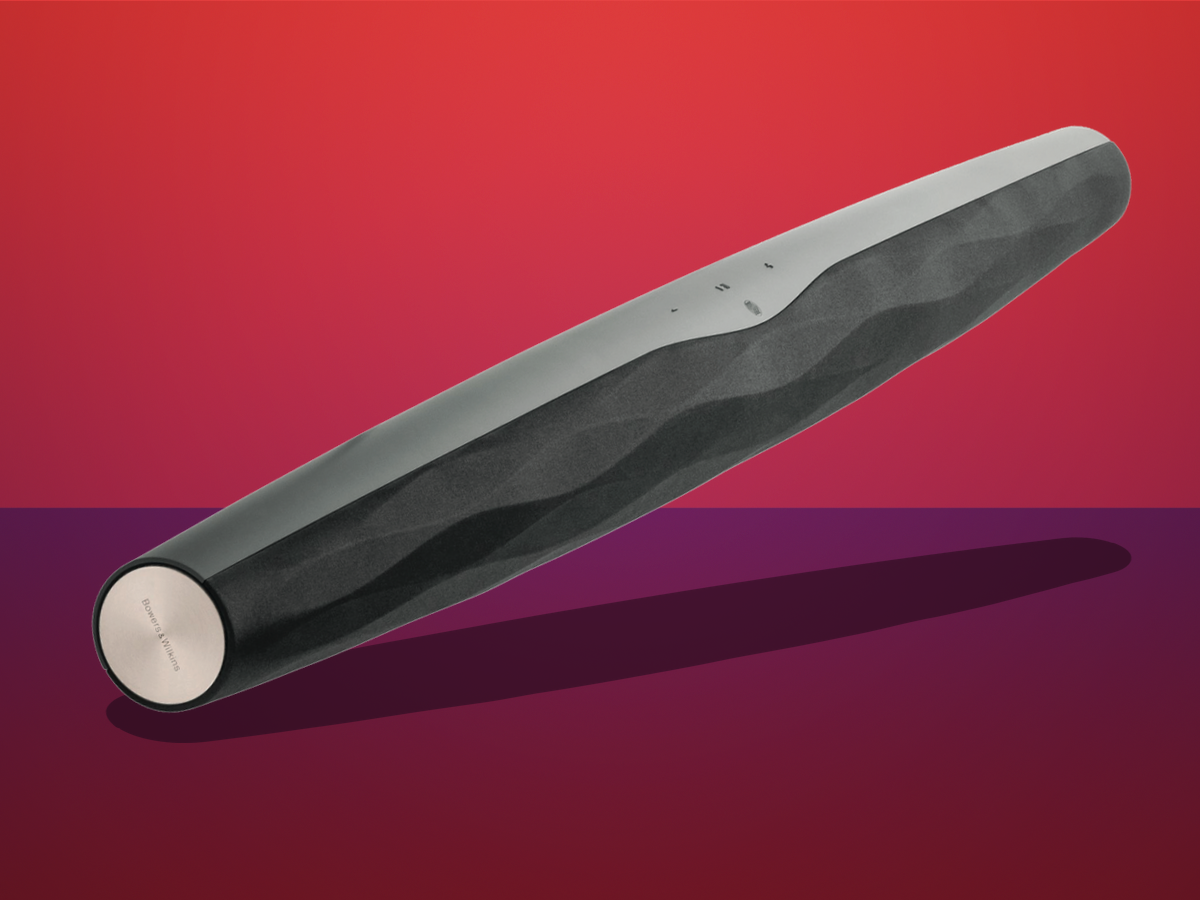
4. Bowers & Wilkins Formation Bar
Stuff Verdict
The B&W Formation Bar is a luxury that will look perfect in your multi-million pound mews house, luckily, it sounds just as good as it looks.
Pros
- Sleek design
- Sounds great
Cons
- Width
- No Dolby Atmos or HDMI
| Bowers & Wilkins Formation Bar specs | |
|---|---|
| Connectivity | Optical, Ethernet |
| Format | Dolby Digital |
| Streaming | AirPlay 2, Spotify, Bluetooth, Wi-Fi |
| Dimensions | 10.9 x 124 x 10.7 cm, 5.5kg 4.3 x 48.8 x 4.2 in, 12.1 lb |
Yes, a thousand pounds sounds like a lot for a ‘just’ a soundbar. But B&W’s Formation Bar does plenty to justify its sizeable price tag – as long as you’ve got space: its wavy shell might seem slim, but at 48.8in / 124cm long it needs plenty of elbow room.
Once you’ve cleared a space, prepare to be gobsmacked by just how capable the Formation Bar is. Nine drivers – including three dedicated to the centre channel – are powered by a total of 240W, generating an extraordinarily wide yet precisely defined and utterly convincing soundstage.
Sure, it’s far from cheap, but the Formation Bar sounds like the jackpot. It packs a fairly meagre selection of inputs, but wireless connectivity is excellent, with integrated Spotify support, as well as Bluetooth and Apple AirPlay 2. It can also handle 24-bit/96kHz tracks via the Bowers & Wilkins Music app. And if you’ve got pennies to spare, it’s easy to pair with additional B&W separates – like the Bass and Flex – for true room-filling audio to accompany your TV.
Best small soundbar

5. Denon Home 550
Stuff Verdict
Denon has doubled your choice of compact, premium soundbars with the Home 550.
Pros
- Good specification and connectivity
- Big, detailed and organised sound at lower volumes
Cons
- Not so good at louder volume
- Not as Dolby Atmos-y as is ideal
| Denon Home 550 specs | |
|---|---|
| Connectivity | HDMI, optical, USB, ethernet, 3.5 AUX |
| Format | Dolby Atmos, DTS:X, Hi-Res Audio |
| Streaming | Wi-Fi, Bluetooth, Google Assistant, Siri, Alexa, Spotify, AirPlay 2 |
| Dimensions | 65.9 x 7.4 x 12 cm, 3.33 kg 25.9 x 2.9 x 4.7 in, 7.3 lb |
Link the Beam (Gen 2), Denon’s Home 550 is a usefully compact soundbar with some Dolby Atmos support. Just the right size to sit beneath a 40-55in TV, it’s both discreet and sophisticated. Its plastic shell is nothing special, but the unit is well-built and finished with a neat acoustic cloth.
As well as DTS:X and Dolby Atmos, the Home 550 can handle full-fat high-res audio – handy if you’re subscribed to a premium streaming service, which you can integrate through the useful HEOS smartphone app.
Sonic services are provided by a pair of 19mm tweeters, four 55mm full-range drivers and three passive radiators. Like the Sonos Beam (Gen 2), none of these point upwards, so the Home 550 relies on algorithms to produce a 3D effect. This is impressive, up to a point: the bar delivers a big sound with noticeable height, showing good dynamic potency and plenty of detail across the frequency range. Bass is deep but controlled, too.
Turn it up and a lot of that quality is compromised, with the Denon losing its poise and composure at higher volumes. But as long as you listen at sensible levels, the Home 550 is a good-looking and likeable soundbar.
- Read more: Denon Home 550 review
Best cheap soundbar
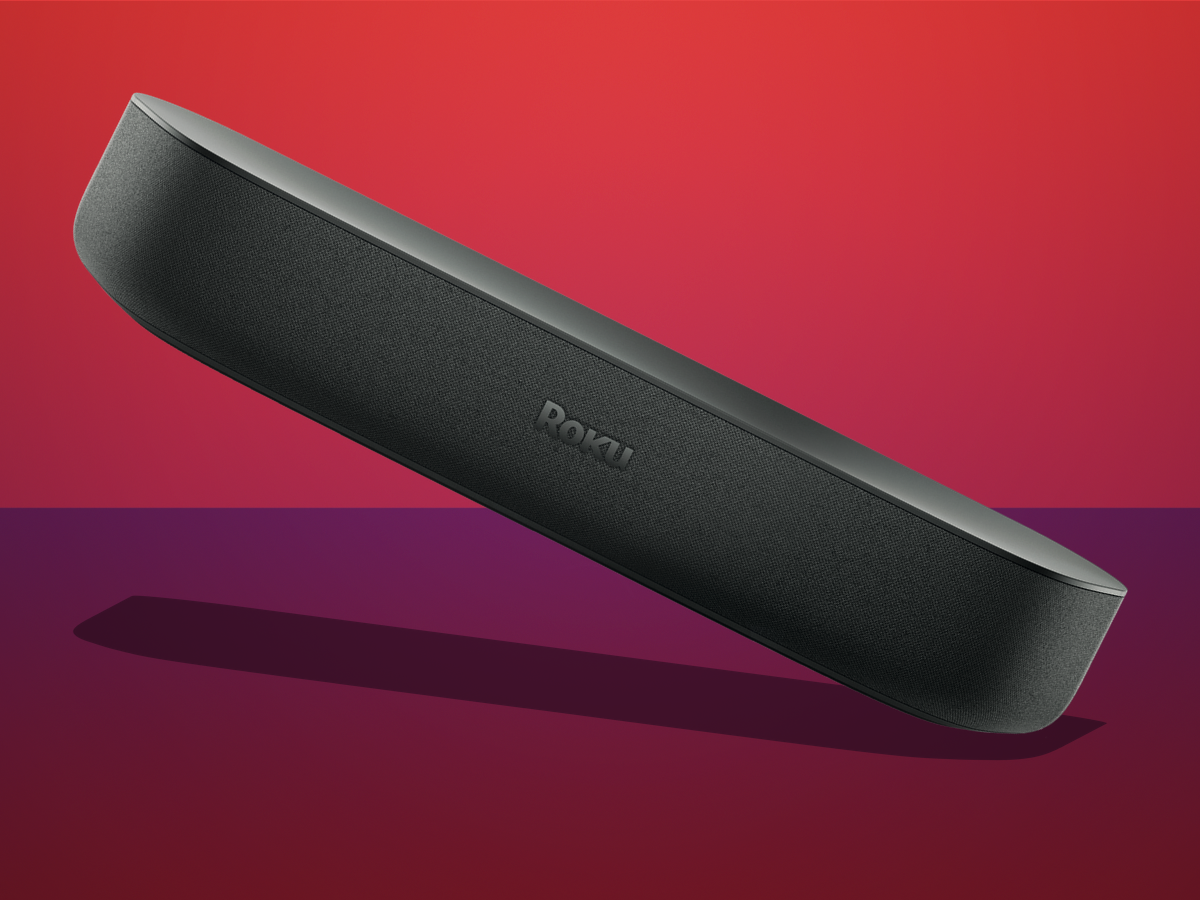
6. Roku Streambar
Stuff Verdict
The smartest little TV double act since the Chuckle Brothers, this is a soundbar and streaming device
Pros
- Great sound for the money
- User-friendly interface
Cons
- Underpowered for bigger rooms
| Roku Streambar specs | |
|---|---|
| Connectivity | HDMI, optical, USB |
| Format | PCM, Dolby Audio |
| Streaming | Bluetooth, Google Assistant, Alexa, AirPlay |
| Dimensions | 356 x 107 x 70mm, 1.1kg 14 x 4.2 x 2.8 in, 2.4 lb |
Roku squeezes the functionality of its widely admired streaming sticks into a small soundbar and produces – ta-da! – a Streambar. No, it can’t compete with the premium rivals in this list, but its four speakers still offer a significant improvement on what any mainstream TV can produce, with way more punch, presence and detail.
Despite the affordable price tag, the Streambar also ships with some smarts, including the option to boost the volume of voices and automatically hush annoying ads. The Streambar also gives you easy access to an absolute stack of streaming and catch-up services, including support for 4K HDR content. There’s a neat little remote, too.
- Read more: Roku Streambar review
Best soundbar for music
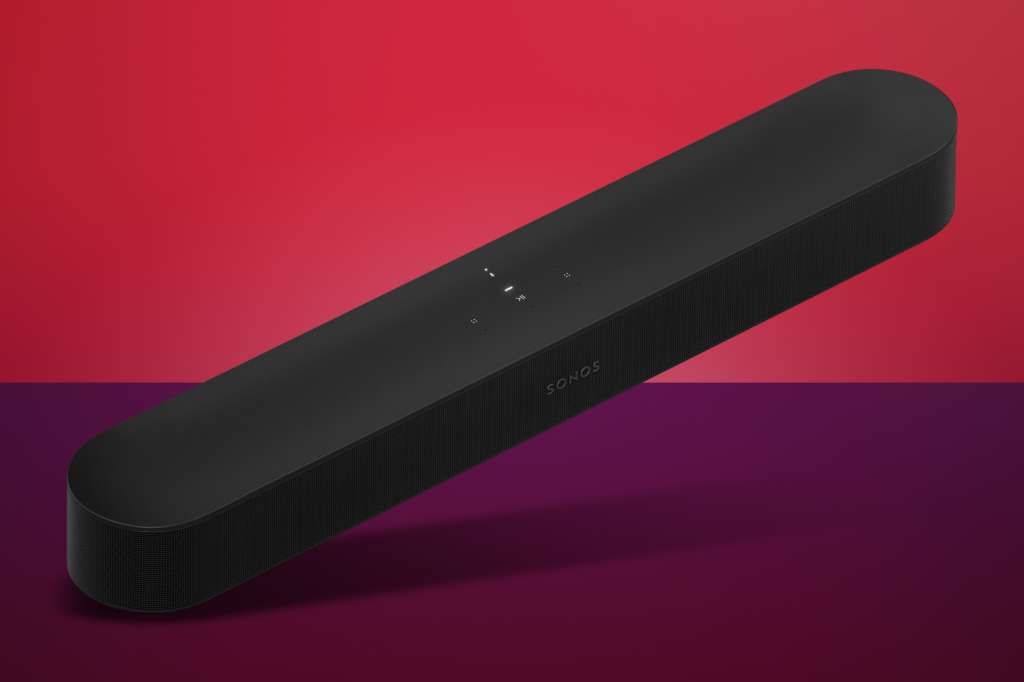
7. Sonos Beam (Gen 2)
Stuff Verdict
The addition of Dolby Atmos makes Sonos’ already excellent compact soundbar even better
Pros
- Atmos works better than you’d expect
- Compact, stylish design
Cons
- Only one HDMI port
- No HDMI passthrough
| Sonos Beam (Gen 2) specs | |
|---|---|
| Connectivity | HDMI, optical, ethernet |
| Format | Dolby Digital, Dolby Digital Plus, Dolby Atmos, Dolby TrueHD, DTS Digital Surround |
| Streaming | Wi-Fi Sonos app, AirPlay 2, Amazon Alexa, Google Assistant |
| Dimensions | 6.9 x 65.1 x 10 cm, 2.8kg 2.7 x 25.6 x 3.9 in, 6.2 lb |
It’s not the biggest soundbar around, but the Beam is still a winner for most living rooms. Low enough to fit beneath the majority of TVs, the second-gen Sonos is set apart from its predecessor only by the polycarbonate grille which replaces the fabric finish of the first edition. Otherwise, it’s visually the same understated slab.
Despite its compact proportions, the Beam (Gen 2) benefits from many sonic smarts. While just a single HDMI port resides in the rear input array, it’s an eARC number – which means it has the bandwidth for Dolby Atmos.
With the same acoustic architecture as the first version, the updated Beam doesn’t have upward-firing speakers for full Atmos immersion. But thanks to psychoacoustic techniques used across five speaker arrays, it does a deft job of replicating overhead effects. Paired with an impressively expansive soundstage, the Beam (Gen 2) is a small but effective solution for superior sound – and you can always add a Sub if you want more whump.
Need more help deciding which Sonos to buy? Read Stuff’s guide to the best Sonos speakers.
- Read more: Sonos Beam (Gen 2) review
Best wall-mounted soundbar
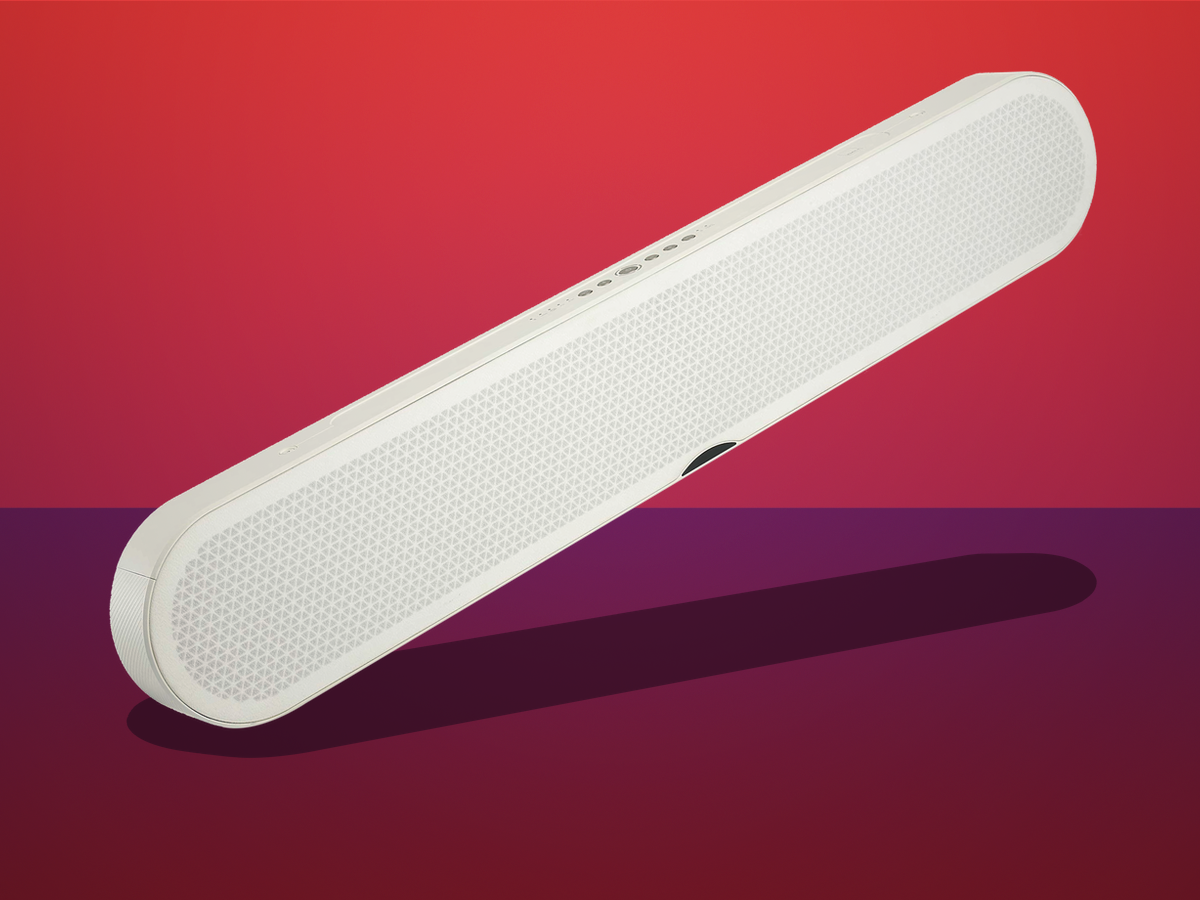
8. Dali Katch One
Stuff Verdict
If you want an alternative to the big brands, the Dali Katch One is an excellent choice. It has fantastic audio and style to match.
Pros
- Sounds and looks great
- Spacial sound is excellent
Cons
- Slightly odd dimensions
- Top-mounted display
| Dali Katch One specs | |
|---|---|
| Connectivity | HDMI, 2x optical, 3.5mm AUX |
| Format | N/A |
| Streaming | Bluetooth |
| Dimensions | 16.4 x 86 x 7cm, 3.7kg 6.5 x 33.9 x 2.8 in, 8.2 lb |
Not every soundbar has to look like, well, a soundbar. Case in point: Dali’s Katch One. Styled more like a wireless speaker than a standard audio sausage, it ships in three shades to suit the decor of your movie room.
Equipped with 10 drivers split between front and back, two do tweeter duty, four function as passive radiators and the final quartet are active woofers which deliver punchy bass. Despite the One’s slimline form, 200W of Class D amplification means power isn’t a problem for the natty noise-box.
Sure, you only get two sound modes – and the Katch can’t compete with Atmos units for sheer scale – but you’ll be hard-pushed to find a better-looking soundbar that also delivers the goods. And it’s arguably worth it just for the matching minimalist wall mounts, which hold the One like Art Deco coat hooks beneath your TV.
Best soundbar with subwoofer
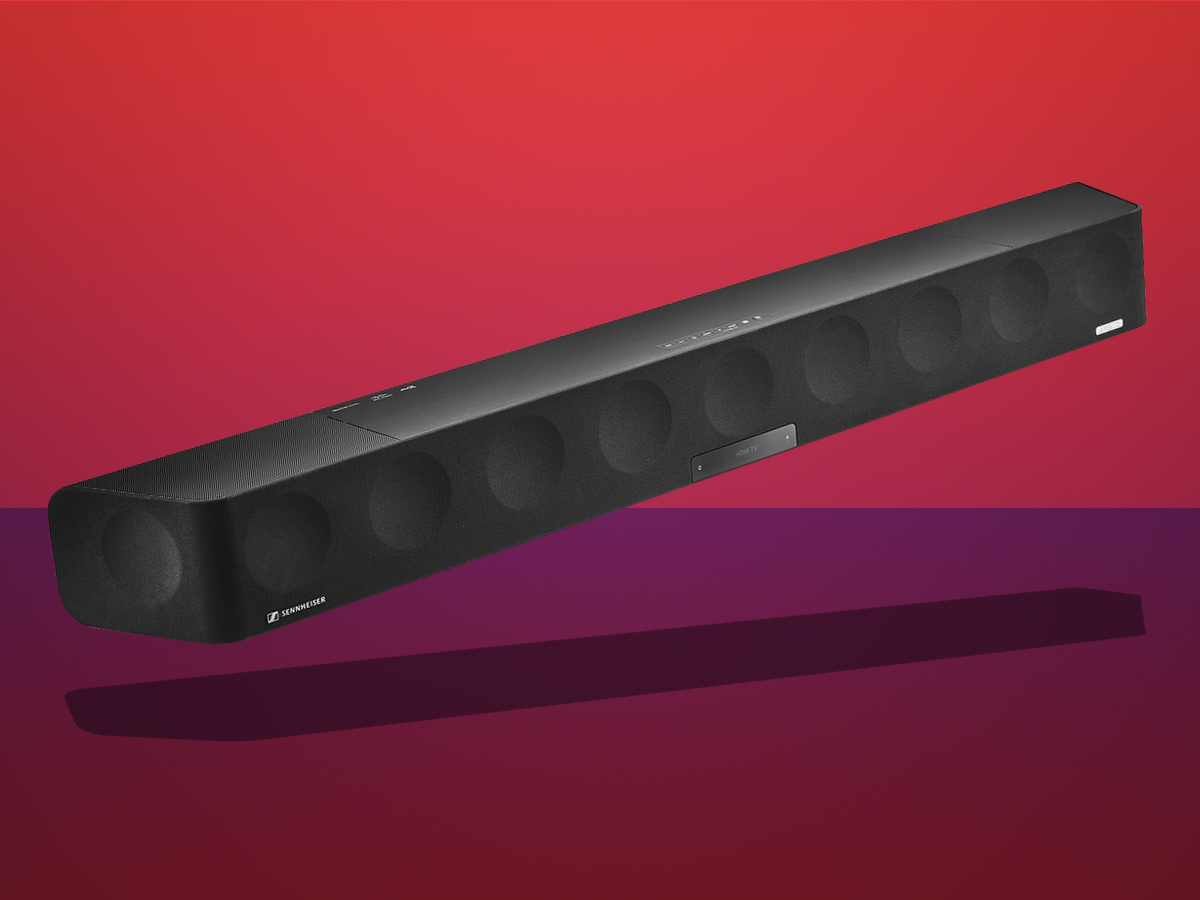
9. Sennheiser Ambeo Max Soundbar
Stuff Verdict
The Ambeo Soundbar is big, but the sound it makes is bigger still
Pros
- Utterly convincing Dolby Atmos and DTS:X 3D sound
- Ample power and lots of inputs
Cons
- Really big
- Very expensive
| Sennheiser Ambeo Soundbar specs | |
|---|---|
| Connectivity | HDMI x4, 3.5mm AUX, optical, ethernet, USB |
| Format | Dolby Atmos, DTS:X, LPCM, Dolby Digital Plus, Dolby True HD, DTS 96/24, DSD, MPEG-H, Sony 360 Audio |
| Streaming | Apple Airplay 2, Chromecast, Spotify Connect, Tidal Connect |
| Dimensions | 126 x 13.5 x 17.1 cm, 18.5 kg 49.6 x 5.3 x 6.7 in, 40.8 lb |
Not many people are willing to drop more than $2000/£2000 on their TV, let alone a soundbar to go beneath it. But if you want the absolute best – and have space for something resembling a futuristic railway sleeper – Sennheiser’s Ambeo is the only choice.
At 49.6in / 126cm long and 40.8 lb / 18.5kg heavy, the Ambeo is massive. But it’s big for a reason: there are 13 independent drivers inside: powered by 500W of Class D amplification. Unsurprisingly, it sounds suitably huge. You won’t get better Atmos performance from a soundbar, with individual elements positioned in their own distinct pockets. Everything is balanced and integrated nicely: the top end is sharp but not harsh, voices in the middle have real texture, while the meaty bass is delivered with so much punch that you’d be silly to bother with a separate sub.
Positioning is important for the Ambeo to perform at its full capacity. A mic is included to assist with setup, which calibrates things by listening to a set of test tones. There’s no voice control once you’re up and running, but the Ambeo goes so loud it would probably drown out your instructions anyway.
- Read more: Sennheiser Ambeo review
Best Samsung soundbar
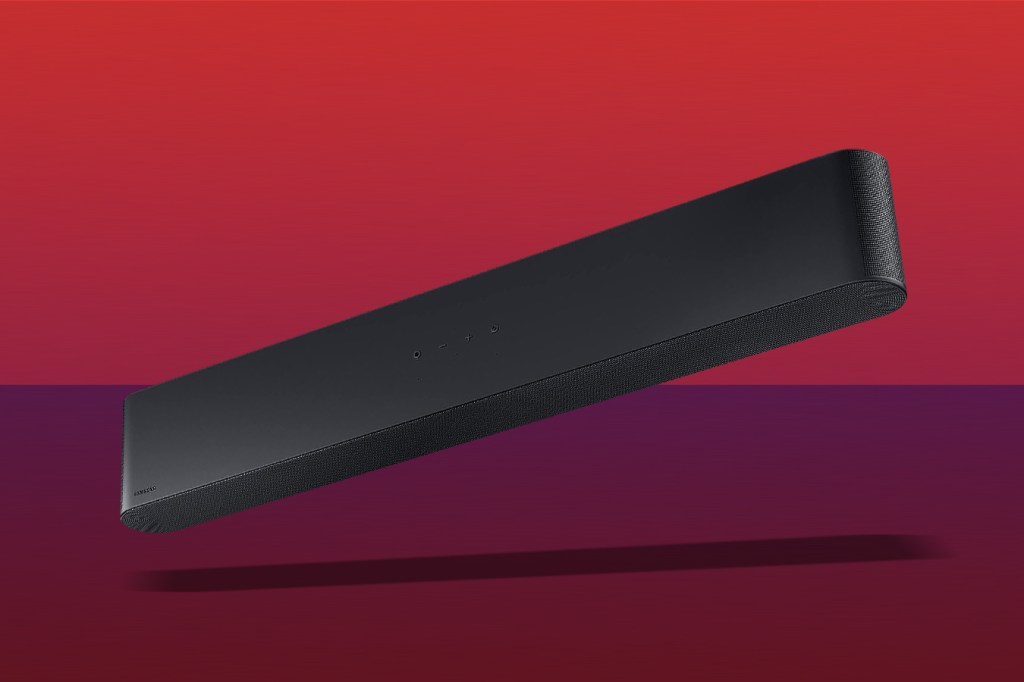
10. Samsung HW-S60B
Stuff Verdict
Sturdy, and punchy, this compact soundbar is at its best when paired with a suitably fancy Samsung TV.
Pros
- Wide soundscape with Dolby Atmos and DTS:X
- Built-in smart assistant
Cons
- No HDMI passthrough
- Only one HDMI port
| Samsung HW-S60B specs | |
|---|---|
| Connectivity | HDMI, digital optical |
| Format | Dolby Atmos, DTS:X |
| Streaming | Wi-Fi, Bluetooth, Apple AirPlay 2, Spotify Connect |
| Dimensions | 670x62x105mm, 2.7kg 26.4 x 2.4 x 4.1 in, 6 lb |
Against the likes of the usual go-to options at this price point (like the oft-mentioned Sonos Beam Gen 2), the Samsung HW-S60B is more of a niche choice, but one with a few key draws. Support for DTS:X, for example, will be welcomed by those with a penchant for physical media. Its wider support in gaming is also something to consider if your console or PC is hooked up to your TV.
If you’re looking for a simple plug-and-play soundbar to boost your regular viewing, you might prefer the Sonos alternative – especially if you’ve already got existing Sonos kit. Alternatively, you could also pick up something like the Sony HT-G700 for the same price. It’s an Atmos/DTS-supporting soundbar that also comes with a sub for beefier bass (though no voice assistant smarts).
Ultimately, you won’t be disappointed with the wider soundscape and punchy audio that the HW-S60B offers. And if you’ve already got a Samsung TV with decent speakers and Q Symphony support, then our recommendation becomes a firm one. The results are something rather unique and impressive, and it makes sense to take advantage of a feature that not everyone will be able to experience.
- Read more: Samsung HW-S60B review
How to buy the best soundbar for you
There are several important factors you’ll need to consider to ensure you get the best possible audio experience for your budget. Below we’ve included some key points to keep in mind when shopping.
The most important thing you’ll need to consider is sound quality. You’ll want to pay attention to the audio clarity, bass response, and overall sound performance. Luckily for you, all of the soundbars on this list have been given the seal of approval from our expert ears.
Soundbars come in various configurations, such as 2.0 (two channels), 2.1 (two channels with a separate subwoofer), 5.1 (five channels with a subwoofer), etc. You’ll want to choose one that suits your space and desired level of immersion. For a truly cinematic experience, look for a soundbar that supports advanced audio formats like Dolby Atmos and DTS:X. These formats provide a more three-dimensional sound experience that is perfect for watching movies.
Of course, if you want ultimate immersion then you may want to pair your soundbar with the best multi-room wi-fi speakers (making sure to get the same brand of speakers and soundbar) to create a true surround sound system. You’ll probably also want to add a subwoofer if you enjoy deep, cinema-like bass.
Size is also a key aspect when it comes to choosing the right soundbar. It may seem basic, but it’s easy to overlook – make sure the soundbar fits wherever you plan to put it.
You’ll want to think about how you plan to use your soundbar and make sure the model you get has the connectivity options to support the devices you plan to use with it. For example, do you want to use HDMI or optical audio, and Bluetooth or Wi-Fi? If your TV has HDMI ARC or eARC, consider getting a soundbar that supports this feature, as it allows for better audio and control over a single HDMI cable.
Finally, some soundbars come with extra features such as voice assistants (think Amazon Alexa and Google Assistant). While these are a nice addition to have, we certainly wouldn’t consider these essential. They shouldn’t affect your purchasing decision.
Are soundbars as good as speakers?
The comparison between soundbars and traditional speakers largely depends on various factors including use case, space constraints, budget, and desired audio quality.
Soundbars are favoured for their space-saving design and ease of installation. They are compact and typically designed to sit below or in front of your TV, making them ideal for smaller spaces or minimalist setups. The setup process is straightforward, usually requiring just one connection to the TV. Soundbars can also be quite cost-effective, especially compared to a full surround sound system. Additionally, modern soundbars often come with built-in subwoofers, Bluetooth connectivity, smart features like voice assistants, and virtual surround sound technology.
However, soundbars have some limitations. Due to their size and configuration, they generally offer a narrower soundstage compared to a set of separate speakers. Even with built-in subwoofers, they typically cannot match the deep, impactful bass that dedicated subwoofers in a traditional speaker setup provide.
On the other hand, traditional speakers offer superior audio quality. A well-configured speaker system, such as a 5.1 or 7.1 surround sound setup, can provide a richer, more immersive audio experience with better spatial separation and dynamic range. These systems are also highly customizable; you can mix and match components, upgrade individual parts, and fine-tune the system to your liking. Traditional speakers are better suited for larger spaces as they can fill the room with sound more effectively, especially with appropriately positioned rear and side speakers.
However, traditional speakers come with their own set of challenges. Installing a full speaker system involves running wires, placing speakers, and possibly configuring a receiver, which can be complex and time-consuming. They also require more physical space and can be visually intrusive with multiple speakers and components. Additionally, high-quality speaker systems can be significantly more expensive than soundbars, especially when considering the cost of additional components like receivers and subwoofers.
Is it worth getting a sound bar for TV?
Yes, upgrading to a soundbar is worth it if you’re looking to significantly enhance your TV’s audio quality over its built-in speakers. Soundbars provide clearer, more dynamic sound, often with built-in subwoofers for better bass, and offer a straightforward, space-saving solution. They can dramatically improve your viewing experience with features like virtual surround sound and Bluetooth connectivity, making them an excellent choice for a more immersive and convenient audio upgrade.
How we test the best soundbars
Over the years, we’ve reviewed countless soundbars by truly living with them – just like you would. We’ve set them up in our own living rooms, positioning them under our TVs, mounting them on walls, and playing with the settings to get that perfect balance of sound. We’ve tested them across all kinds of content, from action-packed blockbusters where the explosions need to rumble the room, to delicate dialogue in indie films where clarity is key.
We’ve used these soundbars for everything – immersing ourselves in the deep roar of a Marvel movie, binge-watching the latest Netflix series, or simply enjoying a quiet evening with soft background music. And yes, we’ve even cranked them up during those impromptu living room dance parties (because who doesn’t do that every now and again?)
Through it all, we’ve come to understand not just how these soundbars perform in ideal conditions, but how they sound in real-world scenarios – where every living room is different, and your media consumption ranges from epic cinematic moments to casual TV time. It’s this hands-on, everyday use that allows us to confidently recommend the soundbars that will truly enhance your home entertainment experience.
We’ve covered various brands, designs and budgets, and for more information on Stuff’s rating and review process, feel free to read our page on how we test products.


